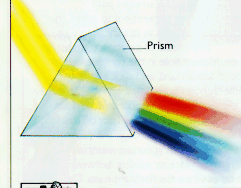
Light is what illuminates the world. It brings color and allows us to see. The sources of light to our earth would be from the sun, lightning, fire, and stars. These aren't the only sources, however. Insects can give off light also (fireflies). Light is made of electrical and magnetic energy that travels faster (985 million feet per second) than anything in the universe. Light that is visible contains colors of the rainbow (the primary colors are red, blue, and green). A prism helps us see the colors of light in a spectrum, which is a collection of wavelengths in an electromagnetic spectrum that arranges colors from violet to red.

We are able to see objects because of our eyes. Without light, however, it is impossible to see. Our eyes allow us to see things far away and close. About four-fifths of the information our brain receives from our surrondings comes through our eyes. The eye is shaped into a ball with a small lens inside. Light enters the eye through the pupil. The pupil is maintained in the colored part of the eye which is known as the "Iris." The retina is the soft, rubbery lens behind the iris that focuses the light onto a layer. The image on the retina is upside down, because the lens bends the light rays toward each other where they eventually cross over. To see clearly, the crossover point must fall exactly on the retina. In Nearsighted people, the light rays cross over in front of the retina. In farsighted people, the light rays cross over behind the retina. Glasses or contact lenses help bring the light rays on the retina so that the person can see clearly. The retina contains light-sensitive chemicals which transform light into electrical messages. These messages are sent along the optic nerve, where they are then turned right-side up and "decoded."
